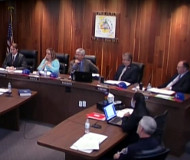8/26/2015
Report: Southern California Red Light Cameras Fail To Reduce AccidentsAnalysis finds no safety improvement from red light cameras in Garden Grove and Los Alamitos, California.

Red light cameras are disappearing from California. Once the state had more than a hundred cities using automated ticketing machines, but by now a greater number of jurisdictions have canceled their programs than have functional cameras. On Monday, the Los Alamitos city council decided to keep its cameras despite a new report showing the devices have not improved safety.
Jay Beeber, Executive Director of Safer Streets LA, provided his analysis of the safety impact of photo enforcement use to the city councils in Los Alamitos and nearby Garden Grove, which is also mulling an extension of its contract with embattled Redflex Traffic Systems of Australia.
The analysis examined accident records from 2001 to 2014 at the two photo enforced intersections in Los Alamitos and the eight cameras locations in Garden Grove. Despite being in place for several years, there has been no statistically significant reduction in accidents. Beeber considered both rear end collisions and accidents where red light running was cited as the cause of the accident. In many camera locations, the overall number of collisions and injuries increased, though the results are less than conclusive because in most cases cameras were installed in locations where red light-related accidents were rare before the cameras were installed.
"Determining whether changes in collision rates are statistically significant is a crucial step in any analysis of collision data, especially where the actual number of collisions is relatively low, which is the case at Garden Grove intersections," the report explained. "This is because small changes will be magnified giving the appearance of a large percentage change when, in fact, the actual change in the number of collisions is small and due only to random fluctuations or regression to the mean."
At the Los Alamitos intersection of Katella Avenue and Los Alamitos Boulevard, for instance, there was no change in the average number of annual red light-related collisions after a decade of photo enforcement. In an entire year, however, the location averaged only 1.6 crashes per year, both with and without the cameras. At Katella Avenue at Bloomfield Street, the annual average dipped from 1.2 to 0.4 after cameras were installed, but the total number of accidents is already so low that it is not statistically possible to tell whether the difference was due to random variability or the presence of cameras.
At the Garden Grove intersection of Brookhurst Street and Orangewood Avenue, rear end, broadside and red light related collisions increased 73 to 107 percent, though the difference was not statistically meaningful. At Valley View Street and Chapman Avenue, rear end collisions jumped significantly from 0.24 per year to 2.0 per year. The location only had a single red light-related accident prior to having the camera installed.
Most of the other locations saw no clearly positive result. At Trask Avenue and Magnolia Street, red light related accidents dropped from 3.0 to 1.4 while rear enders increased from 1.0 to 2.9 -- yet neither change was statistically significant. The number of injuries, however, increased. This basic pattern repeated at Brookhurst Street and Chapman Avenue; Valley View Street and Lampson Avenue; and Brookhurst Street and Trask Avenue. Only Harbor Boulevard and Trask Avenue bucked the trend with a statistically significant drop from 2.7 red light-related accidents to 0.73 per year.
The report recommended further engineering improvements that have shown demonstrable benefits. In January, the city increased the duration of yellow lights at each camera intersection by 0.5 seconds in compliance with new state regulations. The number of automated tickets issued citywide plunged 61 percent overnight.
"This decrease in violations is significantly greater than anything achieved during the 10-plus years of ticketing at red light camera locations and mirrors the kinds of reductions we have seen in other cities when they have increased their yellow signal timing," the report explained.
A copy of the reports is available in a 4mb PDF file at the source link below.


